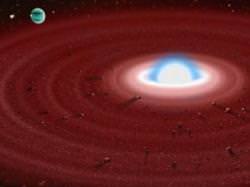Astronomers have found a burned out white dwarf star with the remants of an Earthlike planet orbiting it. This chemical fingerprint gives hope that terrestrial planets, like the ones in our Solar System, could be common across the Universe. Now we just need to find some that havn’t been pulverized into planet powder.
The white dwarf star surrounded by planetary remains is called GD 362, and it’s located about 150 light-years from Earth. Although it’s a dying star, it has a ringlike structure around it like Saturn. During their observations, astronomers from UCLA captured the distinct signature of a rocky asteroid interacting with the white dwarf.
At some point in the recent past, an asteroid was torn apart by the powerful gravitational forces around the compact object, and the dust has polluted the white dwarf’s atmosphere. The relative abundances of elements match the chemical constituents of the planets in the inner Solar System.
Here’s a comment from Michael Jura, a UCLA professor and co-author of the research:
“What we have here is a composition of the white dwarf that is fairly similar to that of the inner planets of our solar system. Are there other terrestrial planets like Earth in other solar systems? This white dwarf’s fingerprint is a significant advance in demonstrating that something like terrestrial planet formation occurred around this other star and probably occurred around other stars as well, because it suggests the Earth’s composition is not unique.”
With this discovery, astronomers have evidence that the kinds of forces that made the Earth and planets in our Solar System happened around GD 362, back when it was a newly forming star. And it gives us a glimpse into the future fate of our planet.
In approximately 5 billion years, when our Sun starts to run out of hydrogen fuel, it will expand out enormously, consuming the inner planets, and maybe even the Earth. The change in the Sun’s density will affect the orbits of all the remaining planets. Some may spiral inward and be consumed by the Sun. Others may spiral outward into interstellar space. Others may collide into smaller and smaller objects. Eventually, our Sun may have its own ring of leftover planetary material. And one of those chunks might be a piece of the Earth.
Original Source: UCLA News Release

